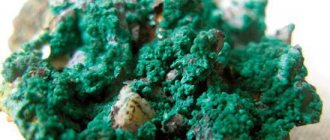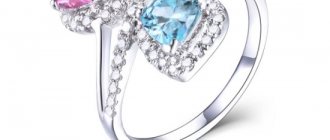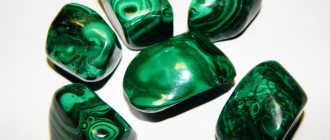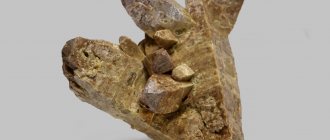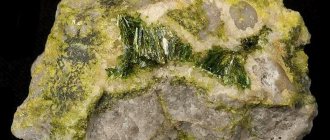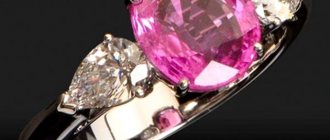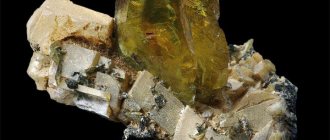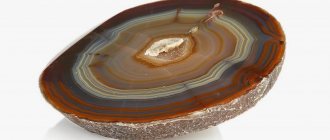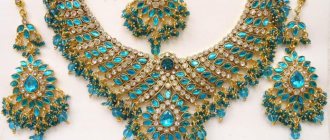The stone known as malachite occupies a special place among the five thousand minerals registered by science. The Russian gem has become famous all over the world not only for its rich green color and fancy graphics. The mineral is also used in healing, decoration and, of course, in the production of jewelry.
What malachite consists of and what it is used for, read our article.
Description and properties of malachite
In Russia, not many ornamental stones were valued as much as malachite. Everyone knew about him, from the imperial family to ordinary people. The masters called the mineral cordial crystal, peacock stone, satin ore, copper greens.
Malachite is a rock with a high copper content. This chemical element gives the stone its green color. Each specimen has its own unique pattern. Decorations and decorative items made from corduroy crystal amaze with their beauty.
In fact, a semiprecious stone acquires its beautiful appearance only after it has been in the hands of stone cutters. A stone removed from the ground looks unattractive and has a faded color. Sometimes the rock is not just stones, but clusters of balls, needle-shaped bunches.
Over the several centuries that people have been familiar with this mineral, they have learned that it has powerful magical and healing abilities.
Physical and chemical properties
The mineral has the following composition:
- copper oxide (approximately 60-70%);
- iron, which is responsible for additional shades;
- carbon dioxide (15-20%);
- water (5-8%).
Plush crystal has physical properties.
| Hardness | 3.5-4 units |
| Refractive index | 1,656-1,909 |
| Shine | Samples from different deposits have different colors: silky with iridescence, matte, glassy. |
| Syngony | Monoclinic |
| Transparency | Opaque |
| Cleavage | Perfect |
| Kink | Splintered, shell-like |
| Density | 3.75 - 3.95 g/cm3 |
| The structure | crystalline |
The color palette of malachite ranges from blue, turquoise to dark green.
Healing and magical properties
Healers know that cordial crystal helps in the treatment of a number of diseases.
| Disease | Name of the amulet | Where to wear, how to use | How it helps |
| Bronchial asthma | Brooch, pendant | On the chest | The number of attacks decreases. |
| Psoriasis | Bracelet | On the right hand | Redness and itching disappear. |
| Eye diseases | Stud earrings | In the ears | Eye pressure is normalized. |
| Night sleep disorders | Ring | On the index finger | Nightmares disappear, sleep becomes sound. |
| Rheumatism | Malachite plates | Apply daily to joints | Reducing pain. |
| High blood pressure | Bracelet | On the left hand | The pressure is stabilizing. |
| Hair loss | Hairpins and combs | Wear hair clips in your hair. Comb your hair with combs twice a day. | Hair follicles are strengthened. |
In order for the healing power of the peacock stone to increase, you must have a talisman set in copper or cupronickel. You can strengthen the body's defenses if you drink melt water for two months, which has stood overnight in a vessel made of velvet crystal. Then you need to take a break for 3-4 weeks and repeat the procedure in the same sequence.
Malachite also helps a person with other problems.
- If there is no mutual understanding between family members, then several malachite products are placed in the rooms. They remove negative energy from rooms.
- The ball becomes a conductor between parallel worlds. Many psychics use it in their rituals.
- Efficiency is increased by placing a pyramid of green mineral in the workplace. This thing will help to concentrate a person’s attention, his official affairs will go uphill.
- Plush crystal is closely related to nature. The magicians believe that the Russian forest gave him power. Therefore, hunters and travelers, in order for their path to be simple, must take malachite with them. It protects the owner from meeting predators.
- Peacock stone has a dangerous property. Psychics do not recommend wearing it all the time. In a man, malachite activates the natural nature - animal instincts begin to dominate him. Free expression of feelings becomes stronger than self-control.
Malachite attracts representatives of the opposite sex to a woman, and not always the most worthy ones. Strange and even dangerous suitors begin to hover around the fair sex. Such connections can lead to dire consequences, even crime. To protect yourself, you should wear malachite jewelry only 2-3 times a week.
A bit of geology
Found in oxidation zones of copper ore and hydrothermal deposits. The mineral is found in weathering crusts.
Chemical process - reaction (interaction) of solutions of copper sulfates with carbonates or carbon dioxide waters.
Malachite from the Democratic Republic of the Congo
Malachite and azurite from Bisbee, Warren County, Mule Mts, Cochise County, Arizona
Malachite in nature
Under the influence of moisture and carbon dioxide, copper gradually turns into green malachite.
Origin story
Archaeologists claim that malachite was mined 7,000 years ago. People have learned to extract minerals located not very deep in the bowels of the Earth.
Helpful information
The ancient Greeks and Egyptians used it to obtain copper. This fact is confirmed by ancient deposits of malachite found by historians in the last century.
Only in the Middle Ages did people learn to process ornamental stone and use it for decorating premises and making jewelry.
Who is suitable according to their zodiac sign?
Malachite has its “favorites”, and for some representatives of the astrological zodiac system it only enhances the negative qualities in their character.
Therefore, according to the horoscope, the mineral is not recommended for Scorpios , Cancer and Virgo .
It influences others very positively:
- Pisces will be able to understand people better and concentrate on the main thing.
- Libra will become even more attractive to others, gaining charisma and charm.
- Aries will gain calm and diplomacy.
- Aquarians will forget past grievances and become more cheerful.
- Taurus will be able to find the root of all problems and failures in life.
- Capricorns will sleep better and stop worrying a lot.
- Sagittarians will demonstrate parental qualities to the maximum and devote more time to their family.
You should give the stone a rest and periodically remove jewelry, and also carefully observe whether it reinforces the negative. Otherwise, use another mineral.
Malachite belongs to the “earthly” element; its patron is Saturn.
Malachite deposits
All over the world they know about modern deposits of malachite, which are located on the territory of the African republics of Zaire and Congo. The first state supplies the market for semi-precious stones with unprocessed copies of the mineral. And the second - samples with visible outlines of geometric shapes and gem-quality stones. This sea green malachite has a silky sheen. Famous couturiers use it in their collections. Models walk down the catwalk in chic outfits and malachite accessories. The beauty of malachite is often brighter than the outfit itself.
In the French Republic there are deposits of turquoise specimens with a glassy sheen. In this state, malachite is carefully mined, observing all environmental standards.
Malachite mining in the Urals
The largest deposits of atlas ore were in the Russian Empire. Mining of malachite in the Urals began in the middle of the 18th century. At first, stone cutters found single specimens of the green mineral, and then places of massive occurrence of copper ore rock were discovered. Blocks weighing hundreds of tons were found in them.
History and features of Ural malachite
These malachite mines were bought by the Demidov family, the richest Russian factory owners. They began not only to mine malachite, but also to process it.
The Demidovs found craftsmen among the serfs capable of processing semi-precious stones and bought them. Ordinary people created real works of art from velvet crystal - room decorations. Stone cutters without special knowledge using the “Russian mosaic” technique worked wonders.
Initially, the so-called “malachite hall” was created in St. Petersburg in the Demidov mansion. This room was so beautiful that, having seen it, Emperor Nicholas I wanted to create something similar in the Winter Palace. The chambers of the majestic persons were ennobled with velvet crystal. Thus, the fashion for creating interior items from peacock stone spread among the Russian nobility. Many mansions had malachite decoration.
MALACHITE HALL IN THE HERMITAGE
In the middle of the 19th century, at the World Exhibition in the capital of Great Britain, one of the Demidovs presented the products of his malachite factory. This is how the “Russian miracle” became known abroad. Any foreign monarch began to consider it an honor to receive a malachite decorative souvenir from the Russian emperor.
Why has the Ural green mineral become so revered in many countries? Because products made from it were of excellent quality. The natural Ural mineral has a unique structure. The surface of the stones is dotted with bizarre asymmetrical patterns. It is this kind of ornament that is especially valued by craftsmen. African modern specimens are much inferior to Russian malachite.
At the moment, this stone is very rare in the Russian Federation. Therefore its cost increases. But scientists express the opinion that at depth in old deposits there are still reserves of copper ore. You just need to invest additional money. But so far there are no patrons who would like to support this idea.
How is malachite mined?
Regardless of where the field is located, production is approximately the same. Where a mineral resource is expected to be found, a shaft is dug, in which fortifications are placed and rails are laid. Miners sort through the rock almost by hand to find grains of malachite. The mined satin ore is transported outside on trolleys.
Popularity of the mineral
This stone became a decoration for the houses of Russian and European nobility. It was even used for cladding rooms, for example, the Malachite Living Room of the Winter Palace. The artistic value of this masterpiece of Russian architecture is difficult to overestimate. The pattern is chosen so skillfully that the joints between the plates are completely impossible to see. The columns of St. Isaac's Cathedral were also lined with malachite. In the chambers of wealthy people one could find such items as a vase made of Ural malachite, watches, snuff boxes, caskets, and even fireplaces and tabletops made of this mineral.
By the way, at that time it was very fashionable to collect interesting samples of various minerals, including malachite. The nobility even competed with each other. Empress Catherine II rightfully received the title of owner of the best collection.
Types of malachite
Masters distinguish the following types of ornamental stone:
- Radiant – dark green specimens with thin veins that look like rays.
- Body (ribbon) stones – light green stones with a bluish, silky tint and a striped pattern
- Zonal – minerals with large or thin rings on a turquoise or bright emerald background.
- Spot-reniform – samples with dark and light stripes
But in nature one constantly comes across malachite that differs from these species. After all, almost every plush crystal is individual.
Varieties
When classifying malachite, the pattern, design and texture are taken into account. Some stones are only suitable for copper mining, but other specimens are quite interesting and can be used for jewelry.
This table will help you understand the groups:
| Name | Description |
Kinds:
|
|
Pseudomorphoses, aggregates, compounds with other minerals:
|
|
Plush
Nodular
Radiant
Pseudomalachite
Atakamite
Chrysocolla
Aurichalcite
Cuprite
Native copper
The mineral composition is similar to malachite. Often they grow together and represent monolithic original specimens.
They are used for the manufacture of decorative items in a single copy, which are especially highly valued.
Malachite + other rocks
After joining, crystals are obtained, which include several gems:
Calcite – malachite
It is a mixture consisting of gypsum, malachite and calcite.
Azurmalachite
One of the most popular combinations, characterized by an interesting greenish-blue tint. Both elements grow together to form one crystal.
Star malachite
Chalcedony is interspersed with round-shaped malachite spots.
Agate – malachite
The latter is expressed by spots of a greenish tone and looks beautiful in the overall structure of jasper.
Eilat stone
A combination of 3 minerals: malachite, chrysocolla and azurite. The stone has a dark, rich green color with bluish inclusions.
Lapis - malachite
This is a duet of quartz and malachite.
Mysoreen
An original gem combining malachite, chrysocolla and calcite.
There is also pressed malachite, which is obtained artificially: small pieces are combined into a single stone using technologies that use high pressure.
Pressed malachite
Malachite Products
Various products are made from satin ore:
- clocks, candlesticks, figurines, pens;
- horizontal surface for tables;
- decorations;
- caskets;
- animal figurines.
All malachite products look great.
Other uses of stone
Malachite products look especially beautiful in any interior, giving it an aristocratic feel: these can be figurines, vases, candlesticks, lamps and boxes, ashtrays.
In ancient times, they learned how to make cladding from thin plates and cover surfaces (tables, columns, etc.) with malachite, but now such work is no longer carried out due to the depletion of deposits.
How to distinguish from a fake?
Since there are few places to extract natural peacock stone, it is often counterfeited. There are many counterfeit technologies:
- Small remains of natural minerals are glued together with hardeners.
- The malachite powder remaining after the work is sintered.
- An artificial corduroy crystal is synthesized.
In the first and second cases, the fake can be seen with a strong magnifying glass. Using the device, you can see chips and irregularities connected with glue. But the synthetic analogue is determined only in laboratory conditions.
IMITATION MALACHITE
What stones does it go with?
The combination of malachite and diamond is beauty, and that’s all
Malachite is “friends” with minerals of the “fire” element: Ruby, pyrope and Diamond.
But other minerals can also become “neighbors”:
- jasper;
- jade;
- chalcedony;
- jet;
- aquamarine;
- emerald;
- moonstone and many others.
Neutral proximity to Amethyst, Chrysoprase, Beryl and Rock Crystal.
Price
Satin ore is a semi-precious stone; its cost is considered to be quite affordable. A gram costs about $5. The products themselves are of course more expensive:
- cupronickel earrings -1000–1200 rubles;
- bracelet – 1000–2000;
- beads – from 3000;
- silver earrings and ring – 4000.
Nature gave the green mineral its strength and beauty and shared with it the power of the forest. Even though the stone is considered semi-precious, in some cases it has no price. If a person sees a malachite product, he will forever be fascinated by its beauty.
Decorations
Malachite is rarely combined with gold. Silver, cupronickel or copper are more suitable for the mineral as a cut. Jewelry is suitable for men and women equally.
For the latter, these are earrings, bracelets, necklaces, beads, rings (worn only on the middle finger of the left hand or on the little finger).
The male half can buy checkers, figurines, cufflinks, watches with thin cupronickel plates inside, backgammon, checkers and chess.
Where was, where is...
There were two industrial deposits in the Urals - Mednorudyanskoye (Nizhny Tagil) and Gumeshevskoye (Polevskoye). Nowadays the mines and shafts here are closed and abandoned.
Mednorudyanskoye (Nizhny Tagil)
Gumeshevskoe (Polevskoe) mine
But in the rock dumps, lovers can find pieces of priceless greenery here.
Expert opinion
Semenishcheva Polina
Specialist in mineralogy. Graduated from St. Petersburg Mining University.
It happened and passed : a block of wonderful stone was extracted from the famous Gumeshki (weighing one and a half tons, this is not a brulik in a ring). Now it adorns the museum of the St. Petersburg Mining Institute.
Geologists pin their hopes on the Korovinsko-Reshetnikovskoye deposit, where malachite was discovered. How much of it there is remains to be explored.
Russia. There were two industrial deposits in the Urals - Mednorudyanskoye (Nizhny Tagil) and Gumeshevskoye (Polevskoye).
Jewelry malachite is mined in Africa (Congo, Zaire).
Nature sprinkled handfuls of gems in France, the mountains of Germany (Harz), and English Cornwall.
Kazakhstan
Malachite is also found:
- Jewelry malachite is mined in Africa (Congo, Zaire).
- Nature sprinkled handfuls of gems in France, the mountains of Germany (Harz), and English Cornwall.
- You can find malachite in Altai and Kazakhstan.
